Tzatziki is a 10-minute yogurt sauce that's essential to Greek and Mediterranean cooking. It's mildly tangy, cool and creamy, and packed with the bold flavors of garlic, lemon and dill.
The beauty of tzatziki is in its versatility and adaptability. Make it vegan by simply using non-dairy yogurt. Swap out the dill for mint. Use more or less garlic or lemon.
Homemade tzatziki is one of those culinary chameleons that can be used as a sauce or a dip to instantly transform veggies, meats, fish, salads, sandwiches, wraps, cheese boards, and mezze platters from basic to flavor packed in record time.
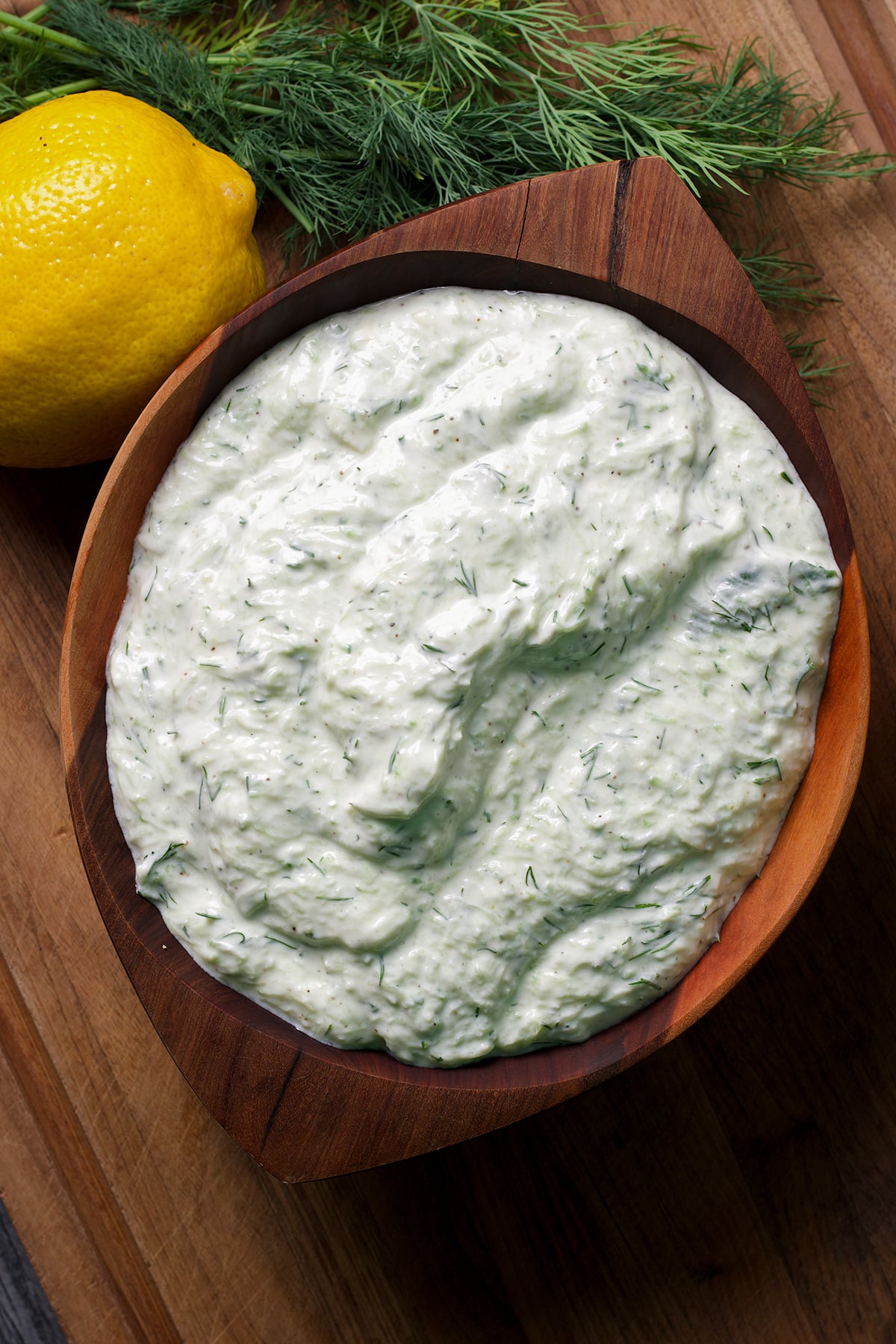
Prepared Tzatziki sauce is readily available in supermarkets, so why would you want to make it yourself?
Recently, I purchased a container of tzatziki to go with my favorite sheet pan Greek meatballs. Even though I’d never had that particular brand before, I blindly trusted that it would be delicious and smothered it all over our meatballs without trying it. Yeah, yeah. You know better. I know better.
It kind of ruined the whole meal. For anyone new here, my husband and I are full-time travelers who life in an RV. As such, I am constantly shopping at different grocery stores, farmer’s markets, and supermarkets. I never know what’s going to be there!
While there is some consistency at “big box” stores, the brands available can vary big time from location to location. As much as I love trying new things, there are certain things I don’t want to take a chance on.
If my meal plan for the week involves something I want to smother with Tzatziki sauce, I want to know that the sauce is going to be good. The only way to do that is to make it myself. And - GOOD NEWS - it only takes about 10 minutes to throw together.
Other reasons to make homemade Tzatziki:
- You can vary it to your personal tastes and preferences. I like mine with a LOT of lemon and dill. You might not. No problem. Make yours as you wish.
- Homemade tzatziki is easy peasy. It takes basically 10 minutes and the leftover sauce will keep in your refrigerator for a few days.
- It uses simple ingredients found everywhere.
- The only difference between traditional tzatziki and vegan tzatziki is using dairy yogurt or dairy-free yogurt.
Jump to:

+ Subscribe to my newsletter for new and exclusive recipes in your in-box every month! As a full time traveler, living, working, cooking, and baking from a 5th wheel RV, it's also where I share our experiences of life on the road.
Ingredients Needed to Prepare this Recipe
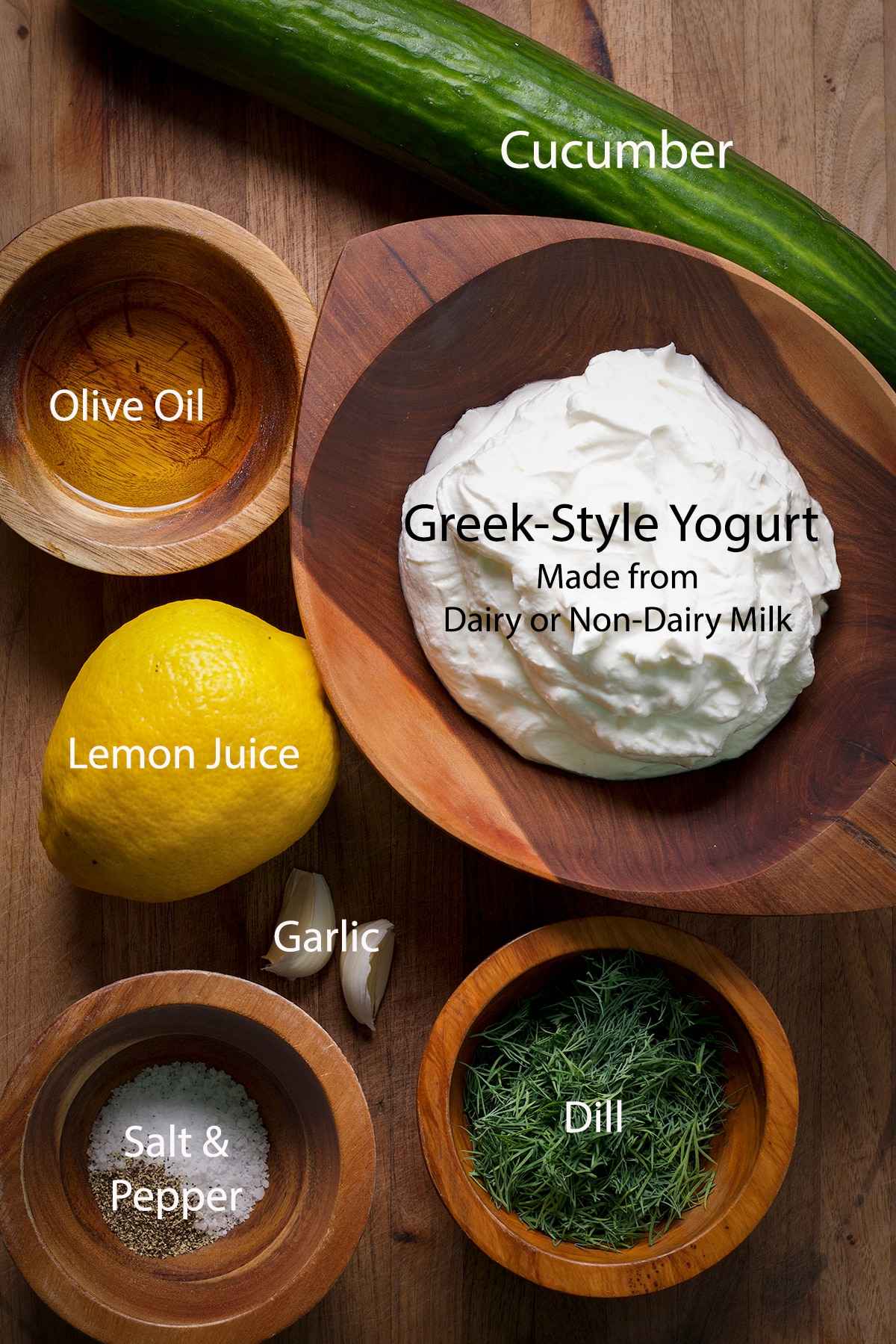
- Grated cucumber. I prefer using English cucumbers to make tzatziki because they are less bitter, have much thinner skins, and seeds that are smaller, softer, and easier to grate - and eat!
- Yogurt! Tzatziki is a yogurt-based sauce so the quality of yogurt you choose is very important. Choose a Greek-style yogurt so that your tzatziki sauce isn't too runny. For traditional tzatziki, use Greek yogurt that's made with dairy, for vegan tzatziki, use Greek-style yogurt that's dairy free. I've included some recommended brands below and in the notes section of the recipe card.
- Extra virgin olive oil. Always an essential part of Mediterranean cooking.
- Fresh dill. Not a fan of dill? No problem. Scroll down to the variations and substitutions section for ideas about what you can add instead.
- Lemon juice. I prefer lemon juice, but you can use vinegar if you like. It's just important to add a bit of acid to brighten and lift up all the other flavors in tzatziki.
- Garlic. How much garlic you add is 100% a matter of personal preference. My feeling is that the garlic should be present, but not dominant. Garlic can vary in potency, so add a clove or two, taste, and then add more if you like.
- Salt and pepper. Always.
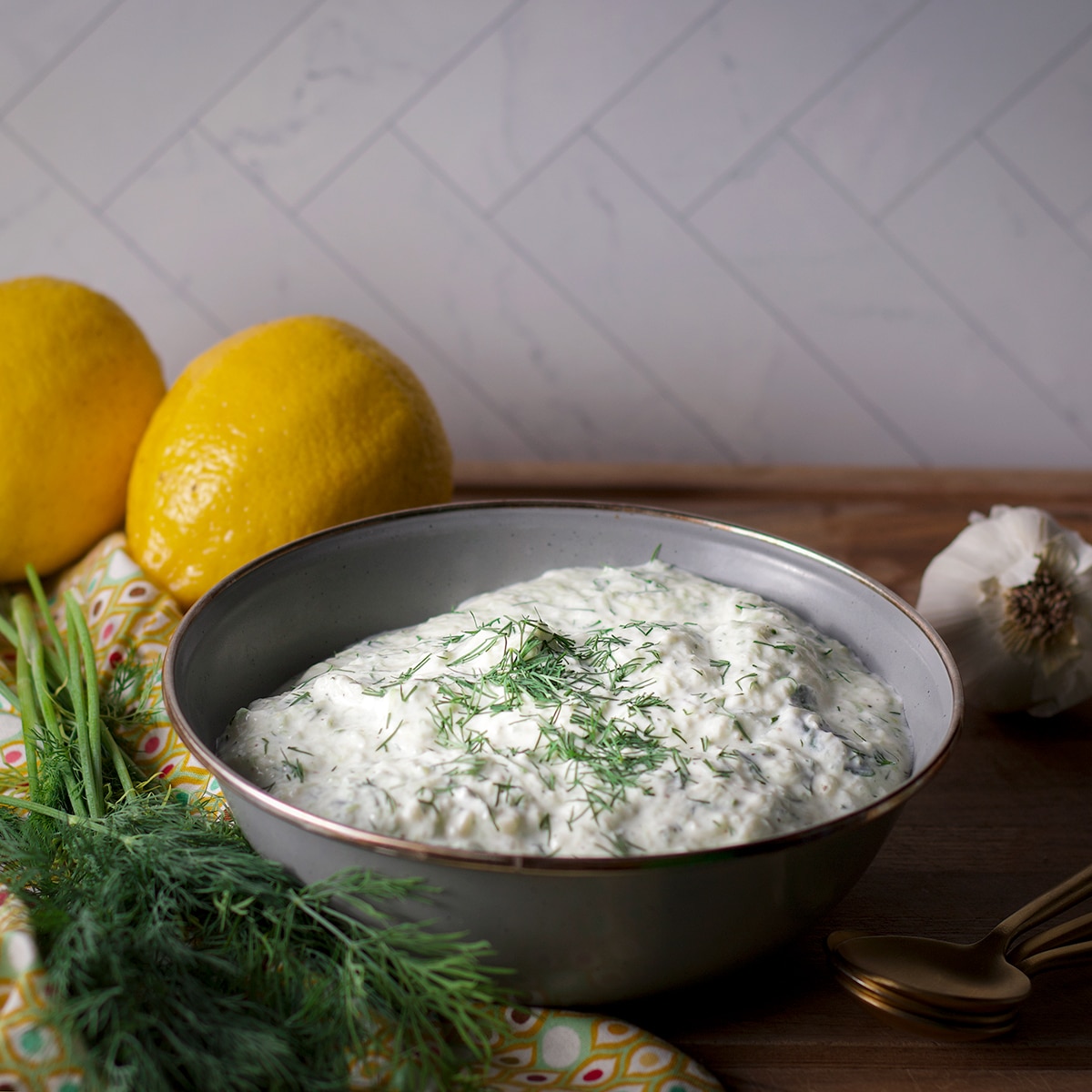
Step by Step Photos and Instructions
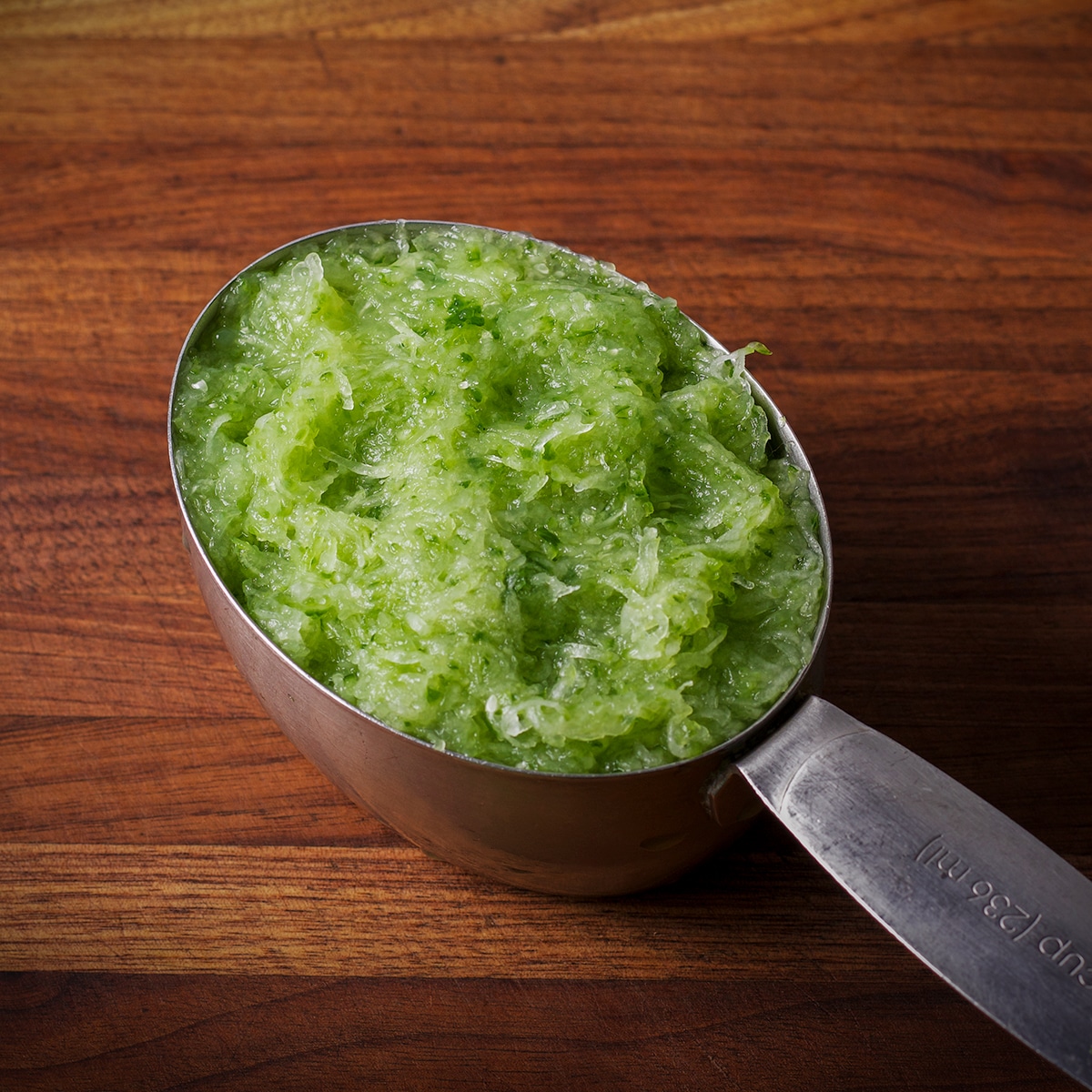
The first step to making tzatziki is to grate a couple of cucumbers. As you do, you will be reminded of an important fact: Cucumbers contain a LOT of water.
If you add the cucumber to tzatziki without squeezing most of that water out, your sauce will be very runny and diluted. So, use your hands to squeeze a lot of the water out of the cucumber after grating it then pack it into a 1-cup measure.
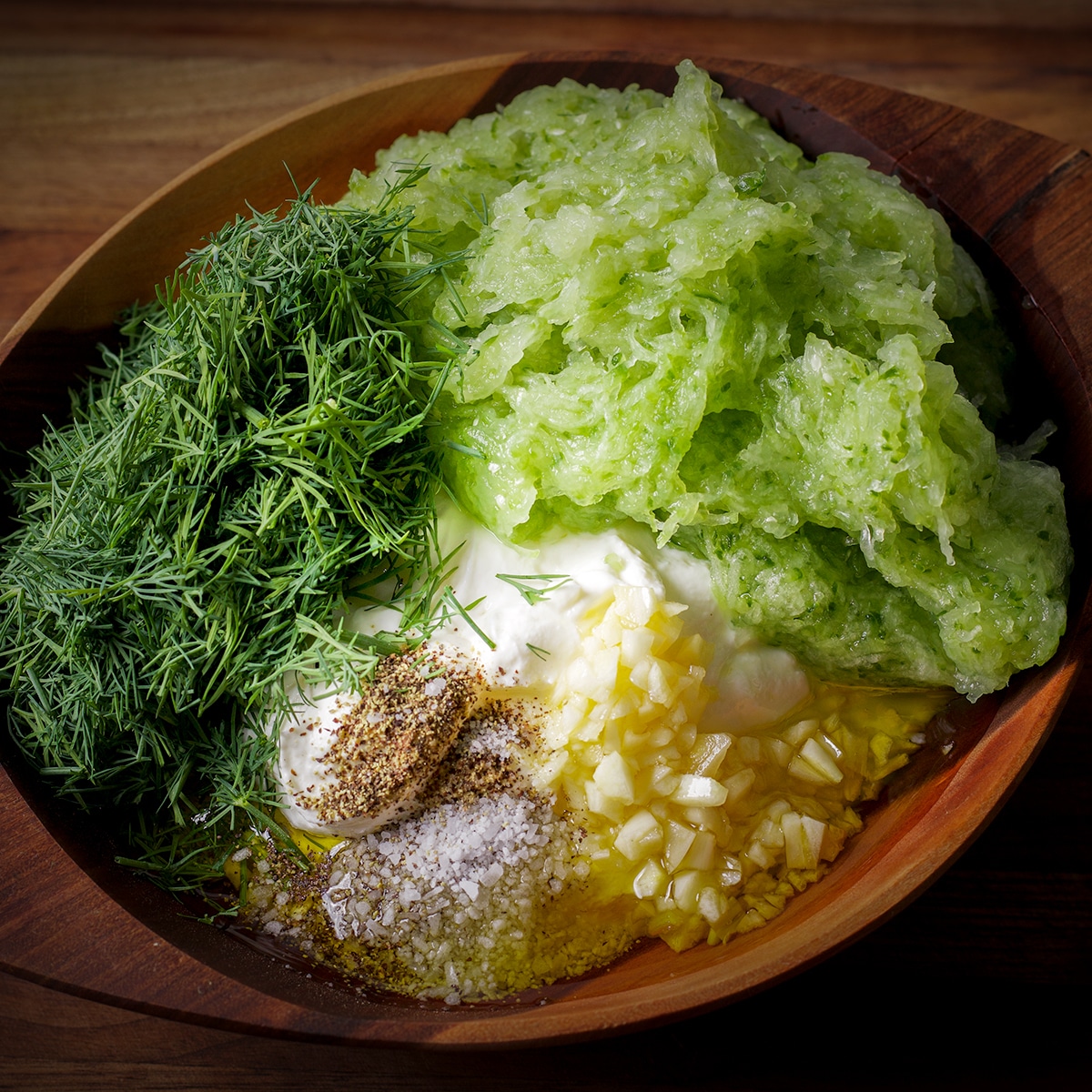
Dump the less watery grated cucumber into a bowl and add the rest of your ingredients.
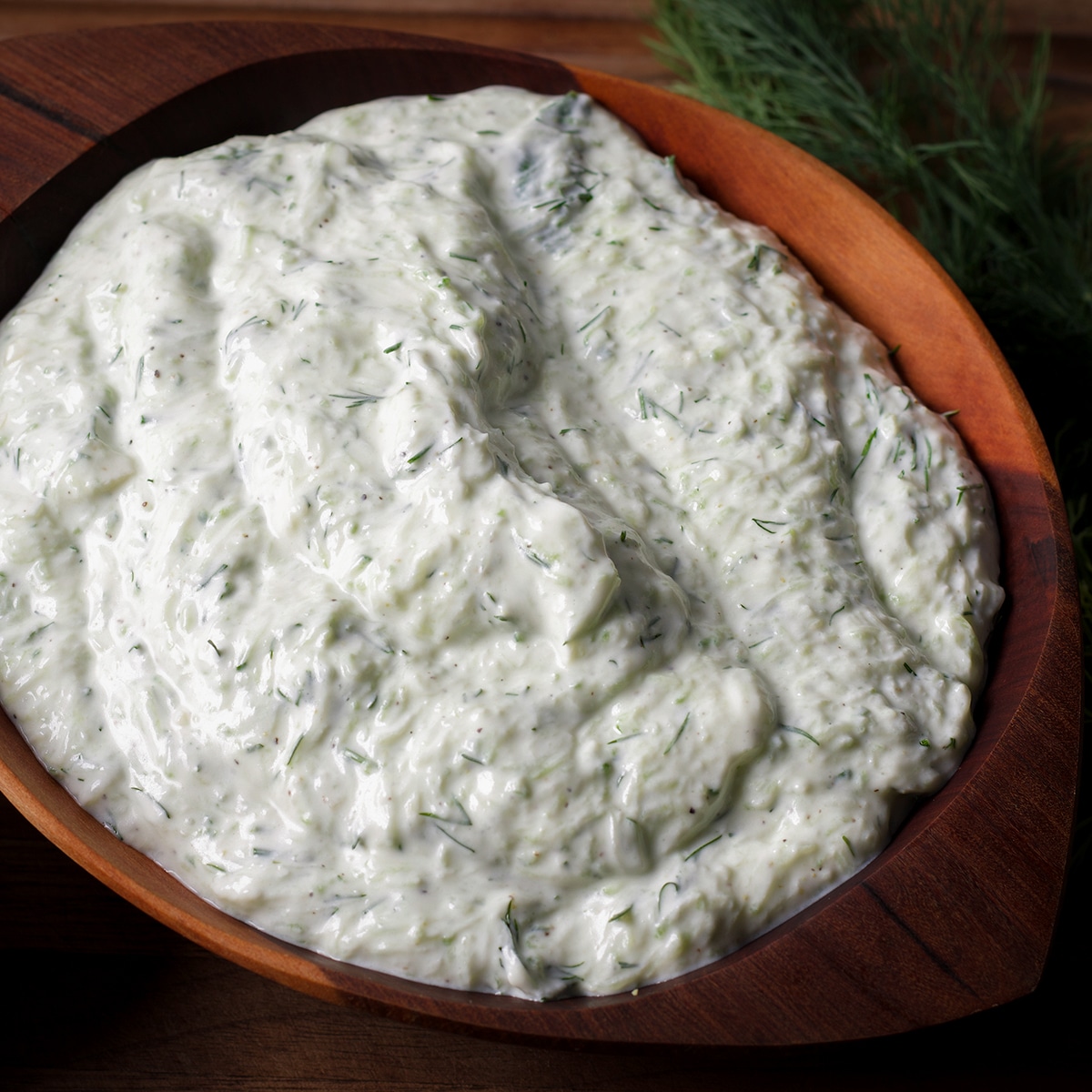
Stir everything together then let it sit for 5-10 minutes to let all the flavors blend.
After letting the tzatziki rest, taste it and add more salt, pepper, dill, lemon, or garlic if you like.
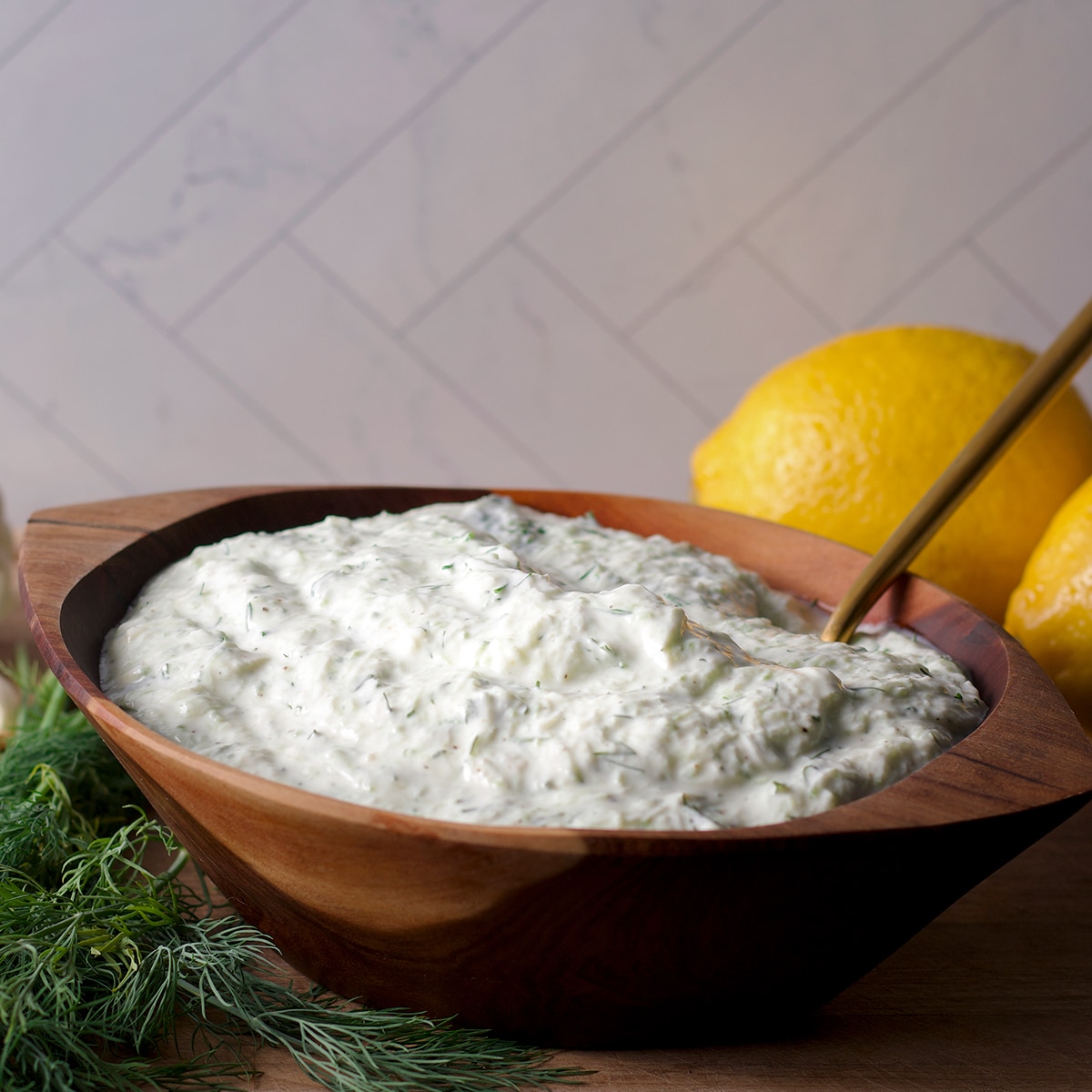
THAT'S IT. Done. Fini. Your tzatziki is now ready to serve. So easy.
Use it immediately or store it in the refrigerator, in a covered container, for up to 3 days.
Variations, Substitutions, and Additions
One of the best things about tzatziki sauce is how easily it can be adapted to your personal tastes and preferences. Tweak it however you like, based on what tastes good to you and what you plan to do with it. Here are a few ideas to get you started:
- Add some Za’atar. Za'atar is a spice mix used in middle easter cooking that is happily gaining popularity everywhere. It's a wildly versatile spice mix and so delicious in tzatziki sauce. Sprinkle it in raw, or (my favorite) toast it for a minute or two in olive oil, let it cool, and then stir it into your bowl of tzatziki. toasting it really opens up the flavors of the spices. If you like za'atar, check out this recipe for Za'atar Labneh, a creamy yogurt cheese dip.
- Instead of, or in addition to fresh dill: My understanding is that truly authentic tzatziki sauce doesn’t even contain dill even though today's tzatziki almost always does. Regardless, if you're not a dill fan, just leave it out or substitute fresh mint, za'atar (as already mentioned), fennel, or Italian flat leaf parsley.
- Instead of lemon juice: Use red or white wine vinegar, or really any kind of vinegar. The important thing is that you add some acid because it really brightens and lifts up the flavor of tzatziki.
- Add chopped nuts: In many parts of the Balkans, variations of tzatziki include chopped walnuts. If this sounds good to you, consider toasting them first and using walnut oil instead of olive oil. You can, of course, use any kind of chopped nuts in tzatziki to add some texture and crunch.
- Add other chopped, crunchy vegetables: Add shredded carrots, chopped celery or bell pepper, or sliced radishes to tzatziki to add flavor, texture, and crunch.
- Add any kind of dried herbs. In Turkey, variations of tzatziki can include aleppo pepper, sumac, or paprika. As with most dried herbs, toasting them for a minute or two in olive oil will really open up and intensify their flavor. For
Aleppo pepper , simply make some Aleppo pepper oil. Allow the spice to cool in the oil then either stir it into the tzatziki or drizzle it over the top right before serving.

Serving Suggestions
Most of us think of tzatziki as a delicious compliment to Greek and Mediterranean food, but you'll find it served across Europe and the Middle East in various forms and with a wide variety of dishes.
Variations of tzatziki are even sometimes served as cold soups.
- Serve it with Greek Meatballs! These sheet pan Greek meatballs are quick and easy and MADE for tzatziki sauce.
- Spoon it onto Gyros. Tzatziki is sometimes called "gyros sauce" because it's essential to the pita-wrapped Greek sandwiches known as gyros. I love to make a salad variation of Gyros, adding grilled meat to salad greens and other chopped vegetables and using tzatziki sauce as the dressing.
- Serve with any kind of roasted or grilled meat or seafood. Like, seriously - any kind. Tzatziki is one of those sauces that goes with pretty much any kind of animal protein. One of my favorites is to serve tzatziki with Grilled Lemon Rosemary Chicken.
- Serve it with any kind of raw or cooked vegetable. Again, I really can't think of any vegetable that tzatziki wouldn't compliment.
- Use it as a salad dressing. Tzatziki can be used as a salad dressing for any kind of salad that might benefit from a cool, creamy touch. I even like to use it over Israeli Salad from time to time, just to switch it up.
- Use it as a dip. Serve a bowl of traditional or vegan tzatziki with pita chips, fresh vegetables, crusty bread, or even skewers of grilled meat or poultry.
- Drizzle it over your bowls. Add instant flavor to any kind of grain, bean, or vegetable bowls, with or without animal protein.
- Dip your fries in tzatziki! Seriously. Swap out the ketchup or aioli for tzatziki and you won't be sorry. For that matter, it makes a great dipping sauce for any kind of veggie fries, like these crispy baked carrot fries!
- Add it to your cheese boards or mezze platters.
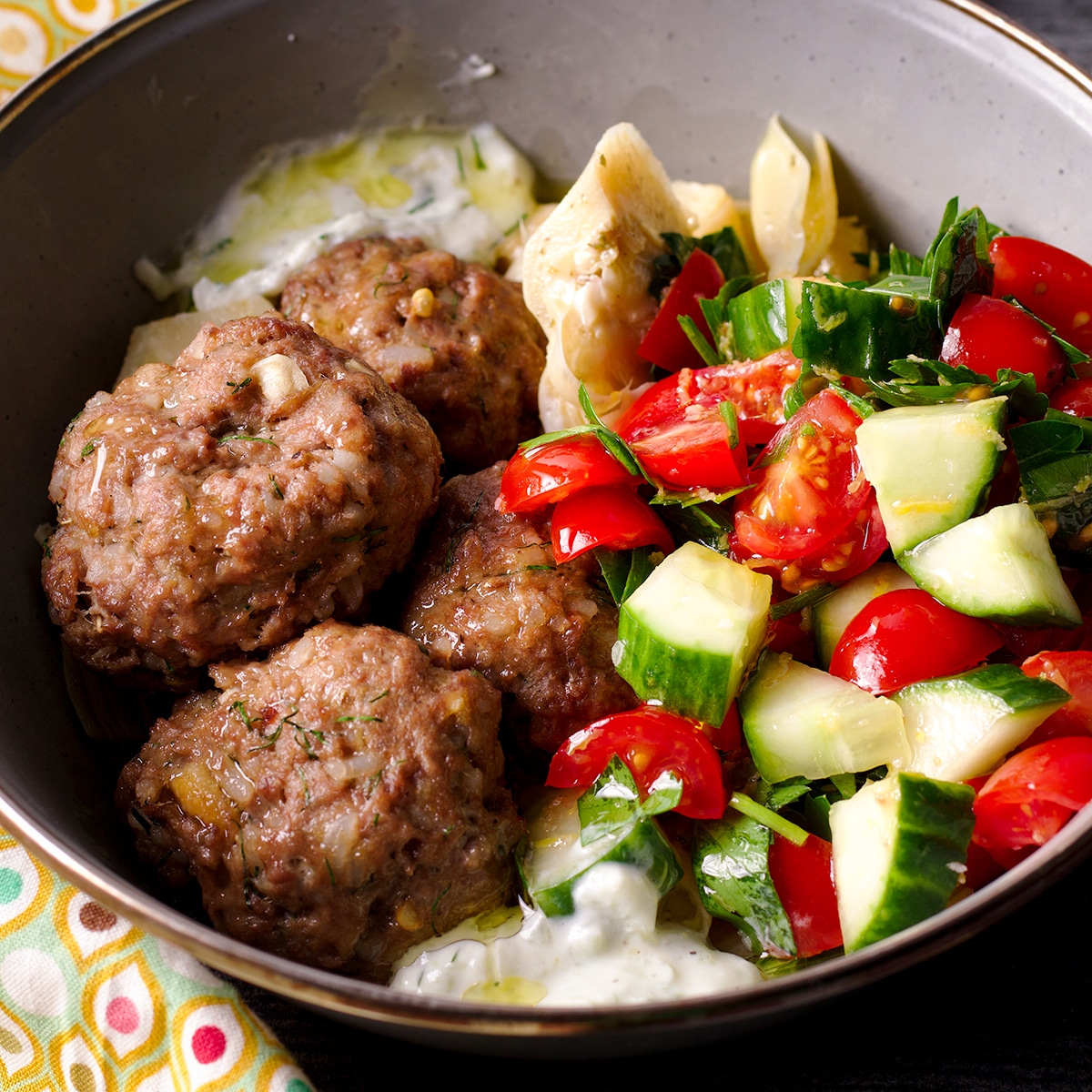
How to Store Tzatziki Sauce
Both traditional and vegan tzatziki is best eaten within 48 hours of making it, but it will keep in the refrigerator for 3 or 4 days.
Store it in a covered container and give it a good stir before serving. The best way to know if tzatziki has gone bad is to smell it. It will have a pungent, off-putting odor if it's gone off.
The other thing to watch for is mold. If you see anything that's dark-colored or fuzzy on the top of the tzatziki, discard it. But generally, you'll notice a rancid odor before any mold begins to grow on it.
FAQs
What’s the difference between traditional and vegan tzatziki sauce?
Every ingredient in tzatziki is plant-based except yogurt, So, to make vegan tzatziki, simply swap out yogurt made from dairy for non-dairy yogurt.
The correct pronunciation is tsah-see-key. That first syllable, "tsah" sounds a lot like the second syllable of "pizza".
However, outside of the Mediterranean, you'll most likely hear people pronounce it tuh·zee·kee, which isn't really wrong, it's just a reflection of having a hard time pronouncing the "tsah" sound.
Absolutely. I prefer to use full-fat Greek yogurt in this sauce, but you can certainly use a low-fat or even non-fat yogurt instead. Using full fat yogurt creates the creamiest texture with a rich mouthfeel. But, the difference is relatively minimal, so use what you like.
The most important thing is to use yogurt that is Greek or Greek-style. Greek yogurt has had some of the whey strained out making it thicker than regular yogurt. Greek yogurt will keep your tzatziki from being too runny.
I usually like to use coconut yogurt to make vegan tzatziki. If you’d like to make your own coconut yogurt, Minimalist Baker has a good recipe.
Otherwise, the brands I like are Forager Organic Dairy-Free Greek Style Yogurt and Culina Plain and Simple.
Kite Hill Greek yogurt is also very good. It’s made from almond milk instead of coconut milk.
Other Popular Dips and Sauces

+ Subscribe to my newsletter for new and exclusive recipes in your in-box every month! As a full time traveler, living, working, cooking, and baking from a 5th wheel RV, it's also where I share our experiences of life on the road.
📖 Recipe
Traditional or Vegan Tzatziki
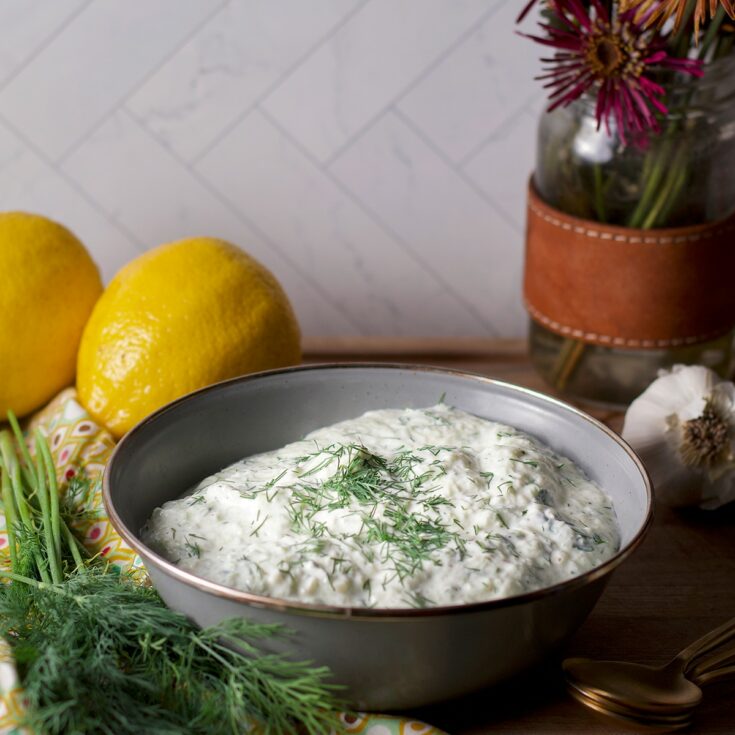
Tzatziki is a 10-minute yogurt sauce that's mildly tangy, cool, creamy, and packed with the bold flavors of garlic, lemon, and dill. Make it vegan by simply using non-dairy yogurt.
Use tzatziki as a sauce or dip to instantly transform veggies, meats, fish, sandwiches, salads, cheese boards, and mezze platters from basic to flavor packed in record time.
Ingredients
- I cup grated cucumber (2 English cucumbers): Please read note below about how to measure
- 1 ½ cups (12 ounces/ 340 grams) plain Greek yogurt OR Greek style vegan yogurt (see note below for recommended brands)
- 2 tablespoons (25 grams) extra virgin olive oil
- 3 tablespoons chopped fresh dill; more or less according to taste
- 1 ½ tablespoons (21 grams) lemon juice; more or less according to taste
- 2 minced garlic cloves; more or less according to taste
- ½ - 1 teaspoon salt, to taste
- ¼ teaspoon black pepper
Instructions
- See the note below about how to measure grated cucumber for this recipe. It’s important to squeeze out excess water from the cucumbers or your tzatziki will be watery and diluted.
- After squeezing the excess water from the grated cucumber and measuring it, dump it into a medium size bowl.
- Add all the other ingredients to the bowl and stir to mix.
- Allow the tzatziki to rest for 5-10 minutes to allow time for the flavors to blend. Tate and add more salt, lemon juice, dill, or garlic if you like.
- Use immediately or store in an airtight container in the refrigerator for up to 3 days.
Notes
How to Measure 1 Cup Grated Cucumber for this Recipe
Measure 1 cup of grated cucumber AFTER squeezing out excess water. This will require about 1 pound and 4 ounces of cucumber, which is generally equal to 2 English cucumbers. Grate the cucumber (no need to peel) and then use your hands to squeeze out excess water. As you squeeze out the water, pack the cucumber into a 1 cup measure, pressing it into the cup.
What Kind of Yogurt is Best to Make Vegan Tzatziki?
If you’d like to make your own coconut yogurt, Minimalist Baker has a good recipe. Otherwise, the brands I like are Forager Organic Dairy-Free Greek Style Yogurt and Culina Plain and Simple.
Kite Hill Greek yogurt is also very good. It’s made from almond milk instead of coconut milk.
Is it important to use English cucumbers in this recipe?
You can use any kind of cucumber you like in this recipe. I usually prefer to use English cucumbers because they are less bitter than regular cucumbers, they have a thinner skin, and the seeds are smaller, softer, and easier to eat.
Recommended Products
As an Amazon Associate and member of other affiliate programs, I earn from qualifying purchases.
Nutrition Information:
Yield:
10Serving Size:
¼ cupAmount Per Serving: Calories: 52Total Fat: 3gSaturated Fat: 0gTrans Fat: 0gUnsaturated Fat: 2gCholesterol: 2mgSodium: 121mgCarbohydrates: 3gFiber: 0gSugar: 2gProtein: 4g




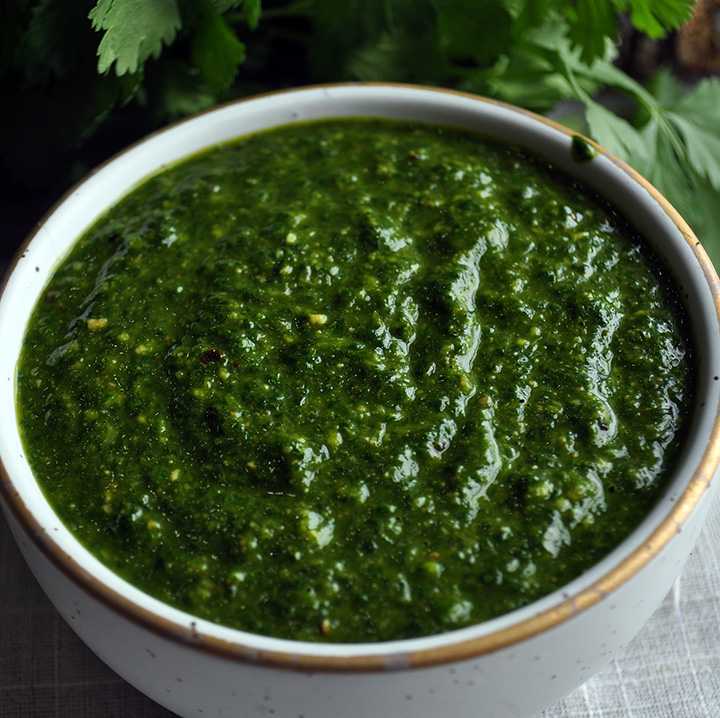






Jamie says
Wow! This dip/dressing looks absolutely delicious and yummy! Perfect dip to our favorite food! Plus the best part is it will take only 10 minutes to have this amazing dip! Loved it!